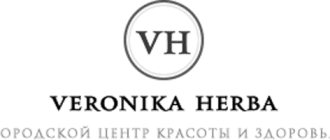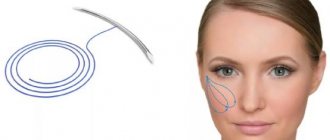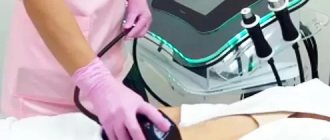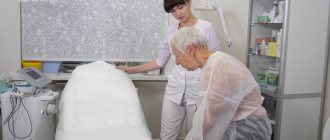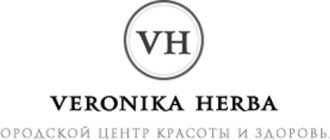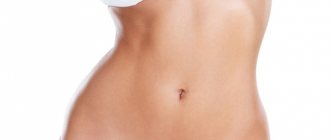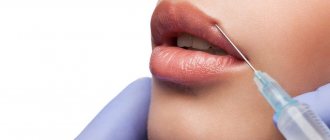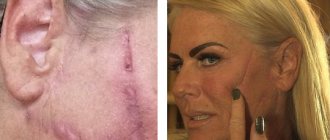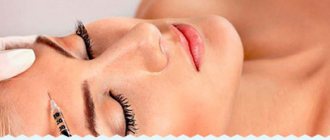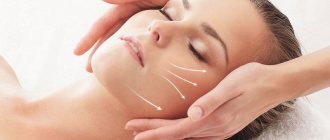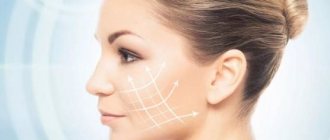No matter how much we would like to grow old, time plays against us, and after 30-35 years the first destructive changes are visible on the face. The face is no longer so fresh, the first wrinkles and spots appear on it, and the folds around the mouth become more and more noticeable. And “residues” after childbirth are visible on the body in the form of stretch marks and fatty deposits. Not everyone turns to a plastic surgeon, citing the fact that it is scary, painful and dangerous to go under the knife. And sometimes there are plenty of contraindications - few people can boast of absolute health at this age. A worthy alternative to surgery has become tissue tightening using thread lifting, for which APTOS threads are widely used.
What is lifting with APTOS threads?
For more than 10 years, the facelift method using APTOS threads has been used in Russia and 48 countries around the world. The founder and discoverer of this method of rejuvenation was the domestic plastic surgeon M. A. Sulamanidze. The idea of using frame supporting threads is practically inseparable from the history of modern surgery.
In cosmetology, suture material, traditionally used in conventional surgery, is used to tighten tissue. With the use of suture material in cosmetology, the era of thread lifting began. The material is highly durable, it does not cause allergies and “gets along” well with soft tissues.
The name "APTOS" is made up of two parts - "a" (negation) and "ptos", which in Latin means "omission". The procedure using APTOS threads literally means “anti-drooping.” After lifting for 1-3 months, new tissue with clear contours is formed at the site of minor damage to the connective tissue.
Many cosmetologists come to the conclusion that a facelift with APTOS threads is an intermediate procedure, when it is too early to correct age-related changes surgically, and all other non-surgical methods no longer produce results.
Pros and cons
It is recommended to resort to lifting with threads in the following cases:
- the presence of wrinkles between the eyebrows and on the forehead (degrees 2–3);
- asymmetry of eyebrows, their drooping;
- drooping corners of the eyes;
- drooping upper eyelid.
A thread lift is suitable for those patients who first turned to a cosmetologist with minor age-related skin changes, as well as for those who have repeatedly resorted to aesthetic procedures.
Contraindications to the procedure due to the introduction of biostimulating materials:
- bleeding disorder, hemophilia;
- oncological diseases;
- skin diseases;
- mental disorders;
- problems with the heart, blood vessels, endocrine system;
- diabetes;
- autoimmune and somatic diseases.
Thread lifting of eyebrows and forehead is not recommended for pregnant and breastfeeding mothers.
Relative contraindications
for the procedure: persons taking blood thinning medications, as well as during exacerbation of chronic diseases.
Those who have a predisposition to hypertrophic and keloid scarring should be careful. They are at risk of developing skin defects.
What types of APTOS threads are used?
- Non-absorbable or surgical - these are polypropylene threads that are inserted no deeper than the subcutaneous fat layer. In this case, the skin receives a strong additional frame, and the nerves and main vessels are not injured. APTOS threads can be smooth, as well as with cones and notches, which allow the material to firmly fix fabrics. This type of lifting is used in areas of pronounced ptosis - these include nasolabial folds, oval of the face, chin area, upper eyelid. The maintained effect lasts up to 5 years.
- Absorbable or biodegradable - in this case, APTOS threads are made of caprolac, which contains L-lactic acid. This series of threads is also called cosmetic threads or “bionic threads”, and the product line is represented by such varieties as Excellence , Nano , LightLift . Notches are made on these threads, thanks to which they are securely attached directly under the skin. The time for biodegradation of the injected material in tissues ranges from 3 months to 1 year. The period of use is up to 2 years.
- APTOS Needle - used only in surgery, as they are made of non-absorbable material and are tightly attached to the tissues in places with small incisions. Typically, this type of thread lifting is performed from the scalp in patients with pronounced age-related changes (50 years and above).
Sometimes the threads are marked 2G, which indicates that these are second-generation threads, which compare favorably with their analogues in design and method of implantation.
Temporary phenomena
Beauty, as you know, requires sacrifice. So-called temporary phenomena accompany most aesthetic interventions - hardware techniques and contouring, peelings and mesotherapy. In most cases, they do not require the participation of a doctor and go away on their own over time. These include:
Ecchymoses (bruises) and small hematomas
Since the doctor works blindly when inserting threads, he can damage small vessels. The likelihood of developing hematomas increases in diseases accompanied by hypocoagulation (reduced blood clotting), or when the procedure is performed during or on the eve of menstruation.
What to do: Just be patient. In ten days there will be no trace of bruises. For those who are especially impatient, special gels and ointments and hardware rehabilitation procedures will help speed up the healing process.
5 days after the procedure and 10 days after the procedure
Edema
They are a natural reaction of the body to any injury. Moreover, with thread lifting, the face may swell differently in different parts of it. Patients with full, heavy faces are more prone to edema.
What to do: Depending on the type of threads and the “extensiveness” of the procedure, swelling will practically disappear in ten to fourteen days. In some cases, medications and hardware techniques can help speed up the healing process.
Skin irregularities
Minor unevenness of the skin is a consequence of tissue movement along traction (tension) vectors, pronounced hypercorrection, and uneven distribution of tissue on the threads. They can also occur in places where the needle is inserted and punctured.
What to do: In most cases, the bumps disappear within seven to ten days. If this does not happen, it is best to contact your doctor.
Before the procedure, a few days after the procedure, a year and a half after the procedure
Disorders of facial expressions
Minor temporary disturbances in facial expressions after the procedure are most often associated with the effect of the anesthetic. They usually go away within a few hours. In rare cases, persistent impairment of facial expressions is possible due to compression (squeezing) of the motor branches of the nerves due to tissue swelling. Direct nerve damage is extremely rare thread lift
What to do: Wait until the anesthetic wears off or the swelling intensity decreases. If the disturbance in facial expression is persistent (more than 3-4 days), you should consult a doctor.
Overcorrection effect
The effect of the procedure is too pronounced - prominent cheekbones - “apples”, “surprised” raised eyebrows, etc. - catches your eye.
What to do: To achieve the best effect, it is best not to take any action for the next few days after the procedure. In fact, doctors even strive for the “overcorrection effect.” Since the swelling after the procedure persists for up to two weeks, and during all this time the force of gravity acts on the tissues that have become “heavier” due to swelling, the tissues consciously rise slightly above the desired position. After two to three weeks they naturally fall into place.
Before the procedure, immediately after the procedure, 10 days after the procedure
At what age is it best to undergo thread lifting?
At what age APTOS threads can be installed is usually determined by a cosmetologist, since the condition of tissues in different patients at the same age may differ. But usually the recommendations are as follows:
- Up to 40 years – both absorbable and non-absorbable types of threads are used. The choice of material depends on their location and places of tightening.
- Up to 50 years - the introduction of only non-absorbable threads is indicated, which can be tightened by the surgeon over time.
- From 50 years and above - the introduction of non-absorbable threads is indicated, which are attached to the skin using incisions and suture material. The length of the incisions is up to 0.5 cm, and the incisions themselves are localized in inconspicuous places (scalp, behind the ears).
The main stage of thread implantation
First of all, the doctor takes pictures of the patient in five projections for subsequent comparison with the results of using thread technology. Next step by step:
1. The patient’s hair is tucked under a cap, and the skin is cleaned of cosmetics and other contaminants. Next, thoroughly treat with an antiseptic solution (betadine, chlorhesidine, etc.) to disinfect the skin.
2. Now it comes to anesthesia. Lidocaine cream or ultracaine solution is used for long-term anesthesia.
3. The doctor marks with a marker the points where the threads will be inserted.
4. The package with threads is opened. This is done in front of the patient.
5. The thread is implanted using a microscopic needle puncture - it is inserted under the skin to a depth of 2 - 3 mm and removed through another puncture.
6. To fix the fabric with notches, the thread is pulled.
7. The needles are removed from the skin, the puncture sites are inspected, and cooling packs are applied to them.
8. After some time, the skin is once again treated with antiseptics.
Which areas can be corrected using the APTOS lifting technique?
In areas with severe sagging skin, surgical sutures made of polypropylene are used, and in other areas, biodegradable material can be used. The areas that are optimally tightened using a specific type of thread are as follows:
- Nasolabial furrows and deep folds.
- Chin area.
- Décolleté and neck areas.
- Eyebrow arches and upper eyelid area.
- Cheek and cheek area.
- Area around the eyes.
- Corners of lips.
- Ear area.
- Abdomen, thighs, arms and chest area.
Execution procedure
Antiseptic treatment of the skin is performed beforehand. Then anesthesia is administered to reduce pain to a minimum (often this is infiltration anesthesia with drugs such as Ultracain DS). For example, to insert Aptos Excellence Visage threads under the skin, a thin guide needle is used. 1-2 punctures are made in the temporal region and ear area to insert threads.
Due to the notches located in opposite directions, the material is securely fixed in the tissues. The skin is instantly tightened, and after a few weeks collagen fibers begin to be produced, due to which the face is lifted and rejuvenated.
Immediately after the procedure, the patient can get up and go home. Minor swelling and bruising will be noticeable on your face for a few days. Pain and discomfort will also soon disappear. To eliminate them, you can use painkillers.
Carrying out the operation of reinforcement with APTOS threads
The procedure takes place in several stages, under local anesthesia. Each thread is inserted separately using a special cannula, and the procedure itself takes from 20 to 50 minutes, depending on the number of threads inserted. So, the stages of the procedure:
- The skin is treated with an antiseptic solution.
- Marks and guide lines are made at the places where the threads are supposed to be inserted.
- Local anesthesia is administered.
- The thinnest cannula, hollow from the inside, is inserted through an injection under the skin or under the fatty tissue.
- An APTOS thread is inserted into the empty cannula.
- The cannula is passed through the lift line and pulled out, leaving the thread in the tissue.
- The thread is pulled slightly at both ends to the required level of tightening.
- The ends of the threads are cut off, and the thread itself remains motionless under the skin.
Additional measures
Three days before the thread lifting procedure, implantation of threads requires:
- stop taking vasodilators and painkillers and alcohol
- do not visit the solarium, sauna or bathhouse, swimming pool;
- do not engage in active sports.
One day before, eliminate foods that cause swelling.
On the day of the event, 2 hours before the procedure, you should not smoke, as nicotine promotes vasospasm and impairs the access of oxygen to the body.
Indications and contraindications for thread lifting
Lifting and reinforcement with APTOS threads, like any procedure, has its own indications and contraindications.
The indications are:
- Atrophy of the skin and the appearance of signs of aging.
- Uneven relief of soft tissues.
- Eyebrow drooping.
- Folds on the forehead, around the mouth and nasolabial folds.
- Tear troughs.
- Deformation of the oval face.
- Folds and sagging skin in various places of the body.
Contraindications for the procedure are:
- The presence of benign and malignant tumors.
- Infectious diseases (acute and chronic).
- Chronic diseases.
- Reduced blood clotting.
- Pregnancy (lactation).
- Formation of keloid scars on the body.
How to fix errors?
Is it possible to do something if the threads are placed incorrectly?
The most radical way to correct errors in this case is to remove threads. However. experienced surgeons can find an alternative if required:
- Trim the nodules (become visible);
- Tighten the threads (they began to sag);
- The face has lost weight and tissue ptosis has increased.
For absorbable Aptos threads, doctors can prescribe physiotherapy procedures that promote rapid biodegradation of the threads.
Perhaps a dermatocosmetologist will recommend additional botulinum therapy or contouring procedures to visually correct the skin texture.
Back to the beginning of the article
Rehabilitation period after the lifting procedure
A facelift with APTOS threads is performed in a surgical clinic or by a cosmetologist, but the procedure in any case does not require hospitalization or hospital stay. The entire rehabilitation period takes on average from 2 weeks to 1 month.
Immediately after injection, swelling, bruising and unevenness may appear, which disappear after 3-5 days.
It is not recommended to massage the area where the threads were inserted, sleep on your side or stomach (preferably on your back), or visit a solarium, bathhouse or sauna for 5-7 days. You should also refrain from active facial expressions and sports (fitness) for a month.
Prices
| Service | Time | Price |
TREADLIFTING - CORRECTION OF FACIAL OVAL WITH THREADS WITH NOTCHES | ||
| Aptos Nano Visage (10 threads -70 mm) | 60 min | 22900rub |
| Aptos Visage Soft (10 threads - 190 mm) | 60 min | 29900rub |
| Aptos Excellence Visage (10 threads - 190 mm) | 60 min | 38900rub |
| Aptos Excellence Body (10 threads - 240 mm) | 60 min | 28800rub |
| Aptos Thread 2G | 60 min | 38900rub |
Anesthesia | ||
| Cream "Akriol Pro" | 30 min | 500r |
| Artikain | 5 minutes | 500r |
Make an appointment
by phone +7 (985) 228-44-55
via whatsapp
Results of facelift with APTOS threads
A distinctive feature of this technique is a one-time visit to the doctor (during administration) and a control visit 2 weeks after the session. The tightening effect becomes noticeable immediately after cosmetic manipulation, and only intensifies over time. The final result becomes visible after a few months.
In addition, reinforcement with APTOS threads helps to even out uneven skin texture, restore youthful oval and facial features, eliminate wrinkles and tighten sagging skin without surgery or incisions. At the same time, facial expressions and facial features themselves do not change, they simply become several years younger!
Aptos Nano
Aptos Nano
–
a new series of delicate
Aptos thread rejuvenation methods that can smooth out wrinkles even on very thin skin. Nano technologies are created specifically for the aesthetic correction of sensitive areas such as the eyebrow area, eyelids, areas around the eyes and around the lips.
For Nano methods, structural threads are used - twisted and spiral. Thanks to their design features, they gently push the skin, straightening it and making wrinkles disappear. In this case, no traces of correction remain, and the natural mobility of the skin is completely preserved.
Threads for Aptos Nano are made from surgical suture material caprolac and L-lactic acid, which has a mesotherapeutic effect. While the installed thread is dissolving, microdoses of L-lactic acid enter the correction area, stimulating the formation of young connective tissue. It is she who takes on the supporting function after the thread frame is completely dissolved. Thus, the Aptos Nano method provides a double rejuvenation effect: long-term lifting, noticeable immediately after the procedure, and tissue renewal that lasts while the threads are in the body.
Features of Aptos Nano threads
:
- Suitable for even the most delicate areas
- 100% biocompatible with body tissues
- 2.5 times thinner than other Aptos threads
- Instantly give the desired result
Possible complications
- The exposure of a piece of thread on the skin, which is easily removed by cutting the thread.
- Weakness that can be eliminated by tightening (not earlier than after a month).
- Bruises and minor bruises.
- An infection that is very rare and can be treated with antibiotic ointments.
